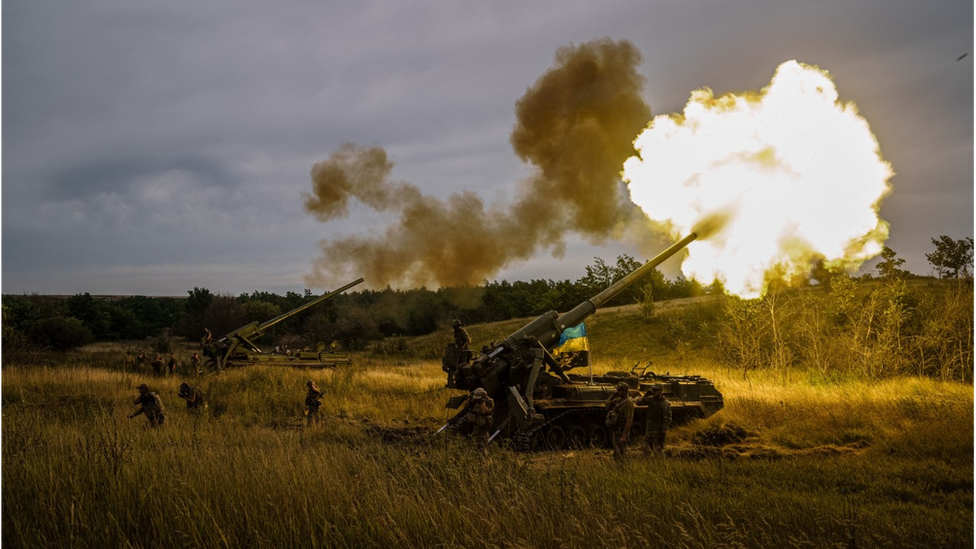In just over a month, winter weather will descend on Ukraine.
It is a circumstance that – despite the recent victories of the Ukrainian army, such as the capture of Kherson this week – could hinder its armed forces in its attempt to continue to recapture the territory occupied by the Russians.
Russia could also try to keep the Ukrainian civilian population cold by attacking more power plants and fuel depots.
We look at how winter can affect conflict.
How cold is winter in Ukraine?
Between December and March, average temperatures in Ukraine fall between -4.8ºC and 2ºC.
On average, it snows for 14 days in december, for 17 days in January and for 15 days in February.
In each of these months more than 1.5 meters of snow fall.
Nevertheless, winters are milder in the south of the country, along the Black Sea coast, than in the north.
How will winter weather affect the war in Ukraine?
In Kyiv, in the north, temperatures are already dropping to freezing point.
In January, the average temperature is -3.8C and at night, temperatures drop to an average low of -6.1C.
However, in the southern region of Kherson, the average January temperature is significantly higher: -0.9C.
The average minimum is -3.7C.
This means that in the front lines in northeastern Ukrainetemperatures can drop low enough for the ground to freeze.
However, on the front lines near the Kherson region, winter snow and rain can turn the soil into mud.

What will winter mean for combat troops?
Muddy ground and deep snow will make it difficult for troops and their vehicles to move quickly.
This would put Ukraine’s troops at a disadvantage, says Forbes Mackenzie, executive director of Mackenzie Intelligence Services, because it would prevent them from advancing quickly.
“Ukrainians will want a cold and hard winter with frozen ground to be able to continue maneuvering quickly and outflank the Russian forces,” he says.
“Nevertheless, the russians will want a warm winter and wet that bogs down the Ukrainians”.
A major problem for both Ukraine and Russia will be how to keep their forces supplied.
“The troops need more food in winter and more fuel to keep warm,” says Ben Barry, a senior fellow at the International Institute for Strategic Studies.
“Nevertheless, both sides are used to cold weather, and their equipment has been designed for cold weather, so winter weather won’t completely stop their troops from engaging,” he says.

How will the winter weather affect the fighting?
Many military experts think that during the winter, both the Russian and Ukrainian armies will focus more on artillery strikes than ground attacks.
“In winter, it is more difficult to deliver supplies and troops are more vulnerable to shortagessays Marina Miron, a defense researcher at Kings College London.
“Both sides will use long-range artillery and drones to attack supply lines and supply depots, with the aim of goal of depleting enemy resources“.
However, fog and snow storms could affect the capacity of each side to detect artillery targets, unless they are using infrared imaging equipment.
Both the Ukrainian and Russian armed forces heavily reliant on drones and many of them are standard types equipped with basic cameras.

Will Russia attack Ukrainian civilians this winter?
Russia has already launched several attacks against areas and facilities civil residential, such as power plants and hydraulic works.
Orysia Lutsevych, director of the Ukraine Forum at Chatham House think tank, says she is likely to continue this strategy through the winter.
“Civilians expect continued attacks on infrastructure, mainly to deprive them of heat,” he says.
“Now people are fueling up like wood and buying stoves and braziers. Places like hospitals are buying their own generators.”
Russia’s strategy is now in the hands of General Sergei Surovikin, the newly appointed commander-in-chief of the forces fighting in Ukraine.

He is known as the “Armageddon General” due to his heavy-handed tactics while commanding operations in Syria and elsewhere.
Your goal is probably to cause a collapse in morale among the population from Ukraine, says Miron.
“Russia believes that if people freeze and despair, they can rebel against their government,” he says.
However, says Lutsevych, Ukraine is relatively well prepared for winter.
“Gas storage facilities are full and you have large supplies of fuel such as diesel,” he says.
“People realize that Russia is not winning the war and that if they can get through the winter, they can have more successes against Russia in the spring.”
Source: Elcomercio
I, Ronald Payne, am a journalist and author who dedicated his life to telling the stories that need to be said. I have over 7 years of experience as a reporter and editor, covering everything from politics to business to crime.

:quality(75)/cloudfront-us-east-1.images.arcpublishing.com/elcomercio/GE4DANJNGEYS2MJSKQYDAORRHA.png)


:quality(75)/cloudfront-us-east-1.images.arcpublishing.com/elcomercio/MCWKZ3IWGNDJDHYRT3TSYDMBWU.jpg)

:quality(75)/cloudfront-us-east-1.images.arcpublishing.com/elcomercio/DJ5UUQ444ZCKXD2CYSN4XFPVOQ.jpg)
